India’s relentless pursuit of indigenous defence technology has reached a defining moment, led by the Ghatak UCAV. For me, this is more than a defence project; it is India’s bold stride into the future of aerial combat, where stealth, autonomy and innovation take centre stage.
On 8th August 2025, ADE confirmed the development of a 2-dimensional thrust vectoring nozzle, a breakthrough that could give Ghatak exceptional agility and precision. With MoD clearance likely by 2027, AMCA technology and the indigenous KDE engine are shaping its final form. For me, this is India’s unmanned leap becoming real.
India has already completed all SWiFT demonstrator test flights, a crucial step towards Ghatak. Building on this success, DRDO’s Aeronautical Development Establishment has rebranded the project as the Ghatak RPSA (Remotely Piloted Strike Aircraft), with the full-scale prototype rollout set for 2026, marking India’s imminent entry into the elite club of stealth combat drone operators.
What is Ghatak UCAV?
The Ghatak UCAV (also called AURA – Autonomous Unmanned Research Aircraft) is a jet-powered, stealth-based unmanned combat aerial vehicle under development by DRDO and ADE for the Indian Air Force.

The name “Ghatak”, translating to “Lethal” in Hindi, is not just symbolic; it embodies the essence of what this platform is designed to achieve. For me, this isn’t just a name; it’s a bold declaration of intent from India, signalling our readiness to engage in next-gen warfare on our terms.
At its core, Ghatak RPSA is engineered for one mission: to venture deep into hostile, contested airspace and neutralise threats without ever putting an Indian pilot at risk. It’s a capability that modern air forces covet, and India is now building it indigenously.
What truly excites me is the autonomy it promises. This isn’t just a drone that follows commands; the Ghatak UCAV is being developed with the intelligence to perform complex missions like reconnaissance, high-risk surveillance, and precision strikes, all while making decisions with minimal human input. This is the future of air combat: smart, stealthy, and lethal, and India is finally stepping into this arena with confidence and conviction.
Ghatak UCAV First Flight and Development Timeline
The developmental journey of the Ghatak UCAV began with the SWiFT demonstrator, a scaled prototype that completed multiple successful autonomous test flights between 2022 and 2023. These trials marked India’s first concrete steps towards mastering stealth drone technologies, paving the way for the full-scale Ghatak RPSA.
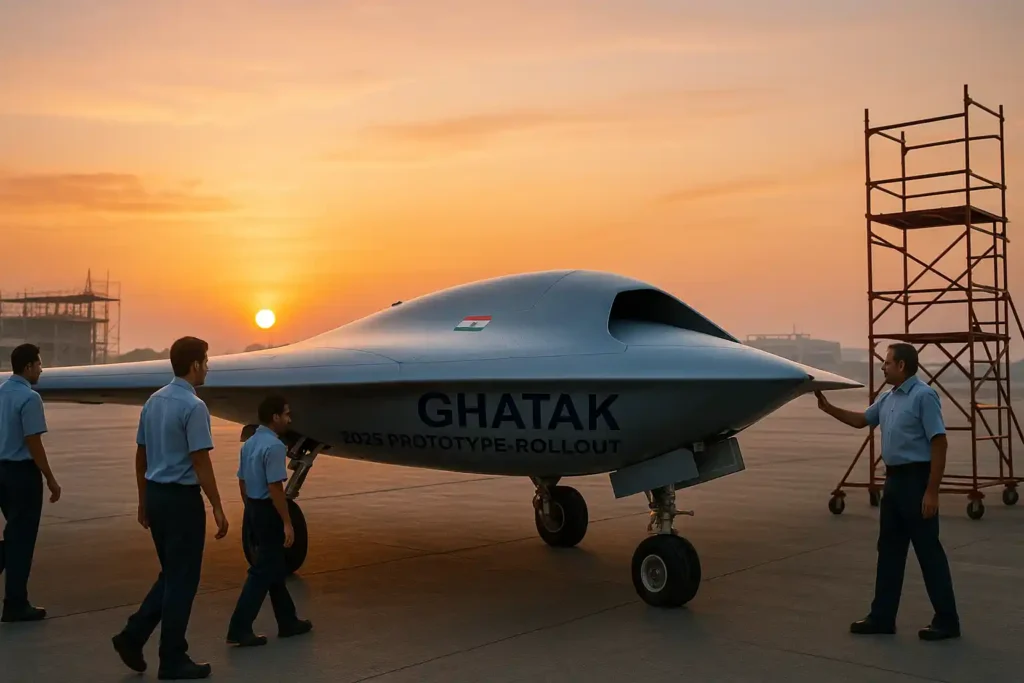
The first full-scale Ghatak RPSA prototype is set to fly between 2025 and 2026, with IAF induction expected by the early 2030s. These milestones reflect India’s firm commitment to achieving Aatmanirbhar Bharat in next-gen combat systems.
ADE Confirms 2026 Ghatak RPSA Rollout
The Aeronautical Development Establishment (ADE) has officially confirmed that the Ghatak RPSA full-scale prototype will roll out in 2026.
This official confirmation aligns with India’s broader plan to enhance airpower alongside the Tejas MkII prototype.
Ghatak UCAV 2025 Update: MoD Clearance, AMCA Tech & KDE Engine Milestone
As of July 26, 2025, the Ghatak UCAV programme has entered a defining stage. For me, this isn’t just another step; it’s India’s vision for 6th-generation airpower starting to take shape.
The project awaits MoD clearance, expected by 2027, following engine certification. Once approved, a ₹3,000–₹ 5,000 crore funding package will support the development of full-scale prototypes.
What excites me is Ghatak’s smart alignment with AMCA stealth technologies, radar-absorbent coatings, advanced avionics, and a low-observable flying-wing design. It shows India is building a unified stealth ecosystem.
Powering it is the 49kN Kaveri Derivative Engine (KDE), which recently cleared high-altitude tests. With certification due in 2026, this could become India’s first frontline indigenous drone engine, a major shift away from foreign dependence.
To me, Ghatak isn’t just a drone; it’s a strategic leap backed by MoD investment, indigenous innovation, and a bold path toward unmanned dominance.
Ghatak UCAV Design and Stealth Features
This flying-wing design, proven by platforms like the B-2, now finds an Indian avatar in Ghatak.
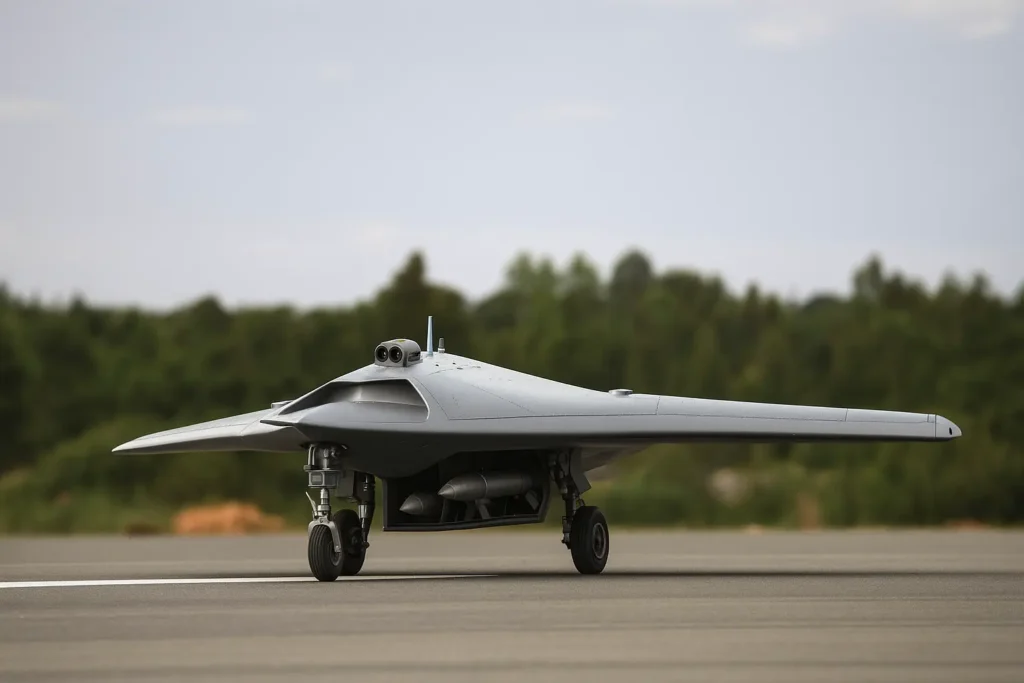
Key Design Elements:
- Flying-wing architecture: Reduces radar cross-section (RCS) for stealth.
- Internal weapons bay: Maintains a stealth profile while carrying munitions.
- Advanced composite materials: For heat signature reduction.
- No vertical stabilisers: Helps avoid radar detection.
This stealth-centric design makes Ghatak ideal for high-risk operations where radar evasion is critical.
2D Thrust Vectoring Nozzle Development for Ghatak UCAV
ADE’s 8th August 2025 Breakthrough
On 8th August 2025, the Aeronautical Development Establishment (ADE) confirmed it is developing a 2-dimensional thrust vectoring nozzle for the Ghatak UCAV. For me, this represents a significant leap towards giving India’s stealth drone the kind of agility and precision usually seen in advanced manned fighters.
Design and Technical Features
The blueprint (GTRE/08-081) reveals a compact, modular design with multiple movable flaps that provide both pitch and yaw control. These are supported by high-strength actuators, advanced cooling channels, and a reinforced mounting frame capable of handling intense operational stress.
Power and Performance Boost
When paired with the GTX engine, a dry Kaveri derivative producing around 50 to 60 kN of thrust, this nozzle could enable supermaneuverability and even the possibility of supercruise. The combination of stealth and extreme agility would allow Ghatak to slip past radar detection, evade incoming missiles, and deliver precision strikes deep inside hostile airspace.
Ghatak Drone Specifications
Dry Kaveri Engine Testing Update – July 2025
As of 17th July 2025, India’s long-awaited Dry Kaveri engine has successfully cleared its high-altitude tests in Russia, a breakthrough that felt overdue but deeply satisfying. Just months earlier, in December 2024, GTRE had already greenlit the engine for in-flight testing, following a series of gruelling trials simulating extreme altitudes, heat endurance, and stress factors.
For me, this isn’t just a technical milestone; it’s a defining stride in India’s ambition to shed dependence on foreign propulsion technologies. With this success, we’re finally seeing the potential of a truly indigenous combat aviation engine, powering platforms like the Ghatak RPSA and reinforcing the vision of a self-reliant India in military aviation.
Dry Kaveri Engine Update: Certification Timeline
The Dry Kaveri 49kN variant is undergoing final in-flight trials in late 2025, with full certification targeted in 2026.
This certification aligns perfectly with Ghatak RPSA’s prototype rollout.
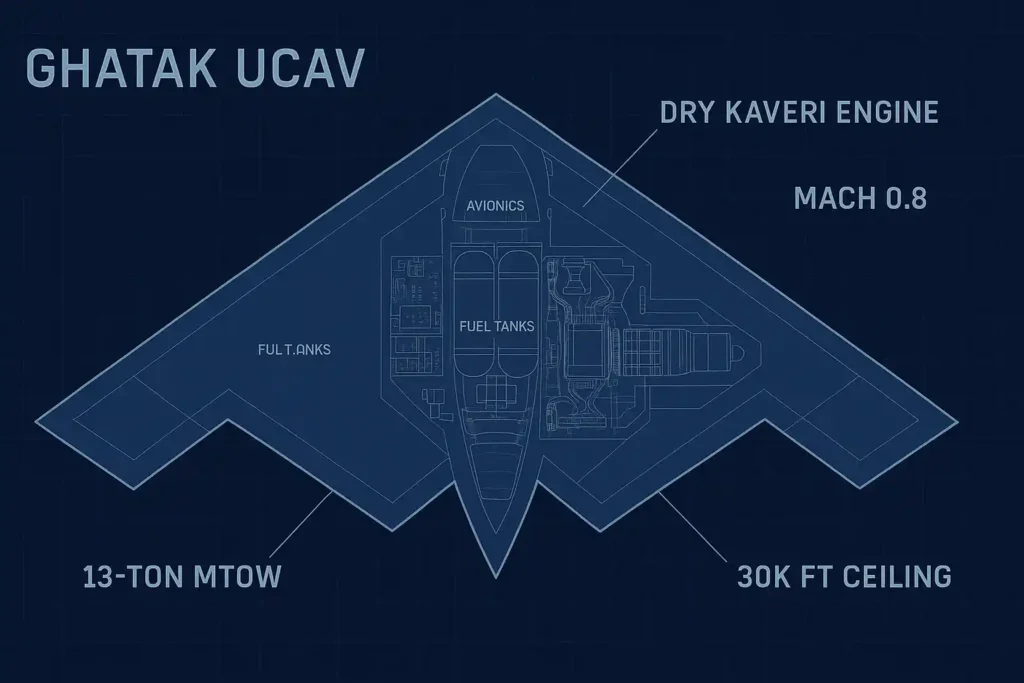
Based on open-source insights and DRDO disclosures, here’s what we know so far about the Ghatak RPSA’s technical profile, and it’s nothing short of impressive.
- Type: Jet-powered unmanned combat aerial vehicle
- Configuration: Sleek flying wing with a stealth-optimised profile
- Engine: Indigenous Dry Kaveri turbofan (~52kN thrust class)
- Maximum Take-Off Weight (MTOW): ~13 tonnes
- Service Ceiling: Around 30,000 to 40,000 feet
- Endurance: Operational range of 1,000+ km on internal fuel
- Speed: Subsonic, cruising at approximately Mach 0.8
Airframe Fabrication and Industrial Partners
L&T has begun fabricating the prototype airframe for Ghatak RPSA
Collaboration between DRDO and Indian industry highlights the indigenous manufacturing push under Aatmanirbhar Bharat.
Ghatak UCAV Payload Capabilities
One of the standout features that could make the Ghatak RPSA a true battlefield game-changer is its 1.5-tonne internal payload capacity, all housed within a stealth-preserving weapons bay.
Likely Weapon Configurations:
- Astra Mk-1 and Mk-2 air-to-air missiles
- Precision Guided Munitions (PGMs)
- Smart bombs and loitering munitions
This versatile loadout enables Ghatak to seamlessly switch between air superiority roles and deep-strike missions, a capability rarely seen in unmanned platforms. It’s this flexibility that could redefine how India approaches unmanned combat operations in the coming decade.
Ghatak UCAV Size and Weight
- Length: Estimated 9 to 11 metres
- Wingspan: Approximately 15 metres
- Weight: Empty weight around 5 tonnes, with 13 tonnes MTOW
This size allows it to carry high fuel loads, avionics, and weapons while remaining manoeuvrable and stealthy.
Ghatak UCAV Price and Cost Considerations
While DRDO hasn’t officially disclosed Ghatak’s unit cost, defence analysts estimate:
- Estimated cost per unit: INR 600 – 750 crore, depending on final configurations
Given its strategic value, indigenous components, and reduced reliance on foreign tech, this is a cost-effective alternative to imported UCAVs.
Advanced Sensors and AI Capabilities
Ghatak will be outfitted with cutting-edge Indian-made sensors:
- Uttam AESA radar for fire control and multi-target tracking
- EO/IR sensor suite for passive targeting
- AI-based target recognition and decision-making
- Secure datalinks for real-time manned-unmanned coordination
These systems allow Ghatak to function independently or as part of a networked combat environment.
Integration with AMCA and CATS Ecosystem
Ghatak is a key pillar in the Indian Air Force’s vision for future air combat:
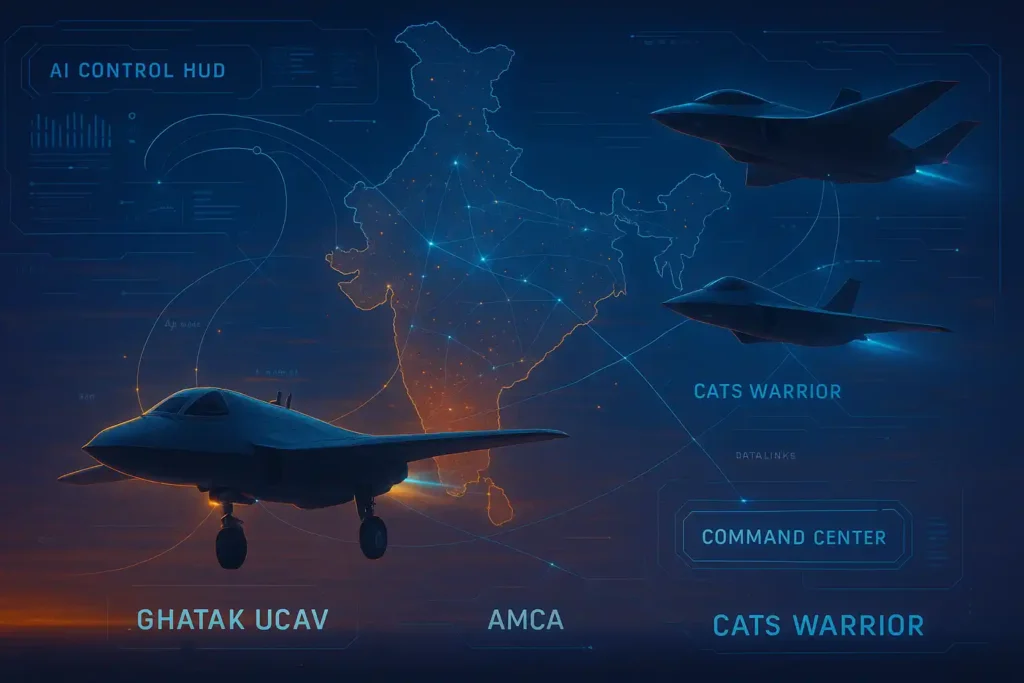
- Manned-Unmanned Teaming (MUM-T) with AMCA, Su-30MKI, and Tejas Mk2
- Operates with CATS Warrior, ALFA-S swarm drones, and Netra AEW&C
- Enables force multiplication in a high-threat airspace
This integration makes Ghatak a game-changer in India’s air warfare doctrine.
Twin Boost for IAF: Ghatak RPSA & Tejas MkII
The simultaneous rollout of Ghatak RPSA and Tejas MkII is being positioned as a “twin boost” for the IAF’s future combat strength.
This synchronisation strengthens manned-unmanned teaming (MUM-T) potential and enhances strategic depth for India.
How Ghatak UCAV Fits into India’s 6th-Generation Warfare Doctrine
The Ghatak UCAV isn’t just another combat drone; it’s a core pillar of India’s 6th-generation warfare strategy, built around stealth, AI, electronic warfare, and seamless manned-unmanned teaming (MUM-T) for future battlespaces.

- Its stealth design allows penetration of hostile radar networks.
- AI capabilities make it suitable for autonomous target identification and engagement.
- Ghatak can act as an electronic warfare decoy, disrupting enemy air defences while coordinating with AMCA.
- Seamless datalink integration enables real-time information sharing across platforms.
This level of interoperability and autonomy places Ghatak among the most advanced unmanned assets being developed globally.
Future Roadmap and Potential Exports
Looking ahead, DRDO plans to continue iterative upgrades to Ghatak based on flight test data:
- Full-scale flight trials: 2025–2026
- Flight test campaign: 2027–2029
- IAF induction: 2030–2032
- Possible naval variant for INS Vikrant and INS Vishal under evaluation
In addition, several friendly nations in Asia and Africa have already shown interest in acquiring India’s indigenous UCAVs, opening the door to future defence exports.
Ghatak UCAV vs Global UCAVs
The 2 Big Unknowns: What We Still Don’t Know About Ghatak UCAV
Despite Ghatak’s promise, two critical uncertainties remain:

- Engine Performance at Full Scale
The Dry Kaveri engine has cleared high-altitude trials, but real tests under full combat loads are still pending. Questions around thrust, heat management, and endurance remain. - Combat Autonomy in Jammed Environments
While Ghatak’s AI is designed for autonomy, its reliability in GPS-denied or intense electronic warfare (EW) conditions is yet to be proven.
These challenges don’t overshadow Ghatak’s promise; instead, they mark the critical hurdles to overcome as it moves from prototype to production.
Even so, Ghatak is shaping up to compete strongly against global UCAV rivals.
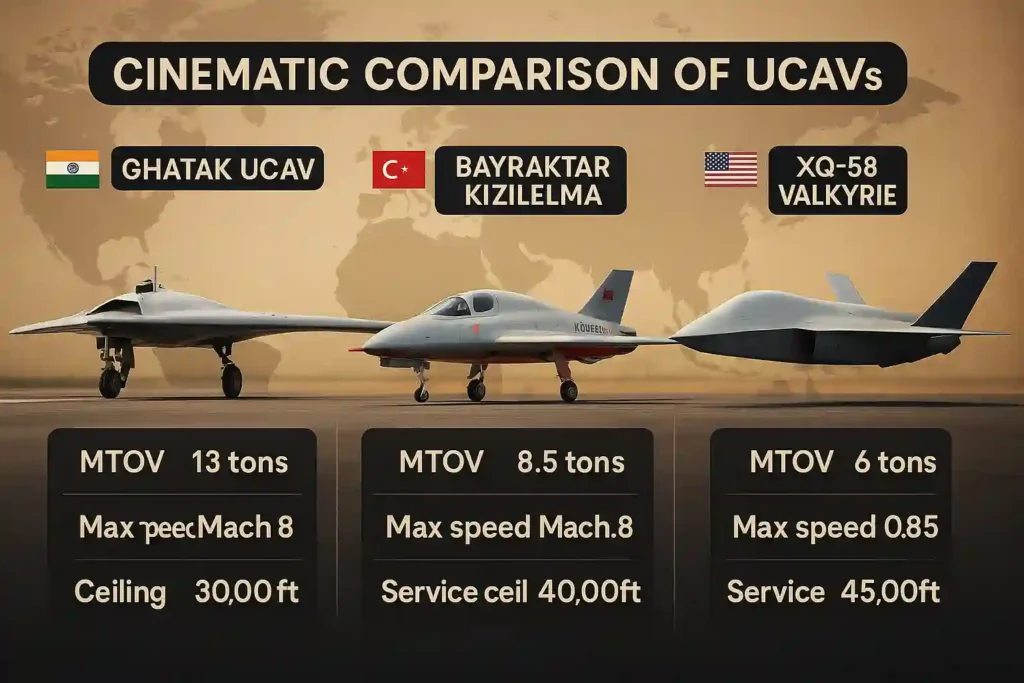
- Bayraktar Kizilelma (Turkey): Ghatak offers better stealth and autonomy
- XQ-58 Valkyrie (USA): Ghatak is heavier with more strike capacity
- nEUROn (France): Ghatak is cost-effective and indigenously scalable
Why Ghatak UCAV Matters for India
India has long relied on foreign systems for strategic strikes. Ghatak changes that narrative:
- Reduces dependency on imported platforms like Predator drones
- Supports Aatmanirbhar Bharat and defence exports
- Creates a new indigenous combat doctrine
- Prepares the IAF for 6th-generation warfare
Conclusion: India’s Flight into the Future
The Ghatak UCAV is more than a drone; it’s India’s bold leap into autonomous, AI-driven combat. With its blend of stealth, precision firepower, and networked warfare, Ghatak is poised to redefine the future of Indian air power. As the first full-scale flight approaches, the world will be watching how it transforms the landscape of modern warfare.
Frequently Asked Questions (FAQs)
- What is the range of the Ghatak UCAV?
Ghatak is expected to have a combat radius of over 1,000 km, allowing deep penetration into enemy territory without refuelling. - When will Ghatak UCAV enter service?
The full-scale prototype is expected to fly by 2026, with operational induction into the IAF by 2030–2032. - Is Ghatak better than Bayraktar Kizilelma?
Ghatak offers superior stealth and autonomy. While Kizilelma is closer to production, Ghatak is designed for deeper strike and advanced networking within a national defence ecosystem. - Can Ghatak operate autonomously?
Yes. Ghatak is equipped with AI-driven mission computers and sensors, enabling it to carry out entire missions without human intervention.
Stay tuned to DefenceNewsIndia for more updates on India’s emerging UCAV and fighter programmes.
